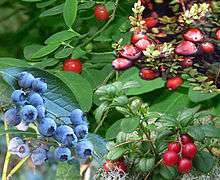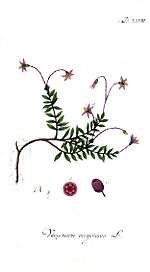Vaccinium
Vaccinium /vækˈsɪniəm/[3] is a common and widespread genus of shrubs or dwarf shrubs in the heath family (Ericaceae). The fruits of many species are eaten by humans and some are of commercial importance, including the cranberry, blueberry, bilberry (whortleberry), lingonberry (cowberry), and huckleberry. Like many other ericaceous plants, they are generally restricted to acidic soils.
| Vaccinium | |
|---|---|
 | |
| Vaccinium berries, from top left clockwise: Red huckleberries, cranberries, lingonberries and blueberries | |
| Scientific classification | |
| Kingdom: | Plantae |
| Clade: | Tracheophytes |
| Clade: | Angiosperms |
| Clade: | Eudicots |
| Clade: | Asterids |
| Order: | Ericales |
| Family: | Ericaceae |
| Subfamily: | Vaccinioideae |
| Tribe: | Vaccinieae |
| Genus: | Vaccinium L. |
| Type species | |
| Vaccinium uliginosum[1] | |
| Synonyms[2] | |
| |
Description
The plant structure varies between species: some trail along the ground, some are dwarf shrubs, and some are larger shrubs perhaps 1 to 2 m (3 to 7 ft) tall. Some tropical species are epiphytic.[4] Stems are usually woody. Flowers are epigynous with fused petals, and have long styles that protrude from their bell-shaped corollas. Stamens have anthers with extended tube-like structures called "awns" through which pollen falls when mature.[5] Inflorescences can be axillary or terminal. The fruit develops from an inferior ovary, and is a four- or five-parted berry; it is usually brightly coloured, often being red or bluish with purple juice. Roots are commonly mycorrhizal, which likely help the plants to access nutrients such as nitrogen and phosphorus in the acidic, nutrient-poor soils they inhabit.[4]
Taxonomy
The genus was first described scientifically by Carl Linnaeus in 1753.[1] The name Vaccinium was used in classical Latin for a plant, possibly the bilberry or a hyacinth, and may be derived from the Latin bacca, berry, although its ultimate derivation is obscure.[6][7] It is not the same word as Vaccinum "of or pertaining to cows".[8]
The taxonomy of the genus is complex, and still under investigation. Genetic analysis indicates that the genus Vaccinium is not monophyletic.[9] A number of the Asian species are more closely related to Agapetes than to other Vaccinium species.[9][10] A second group includes most of Orthaea and Notopora, at least some of Gaylussacia (huckleberry), and a number of species from Vaccinium, such as Vaccinium crassifolium.[9] Other parts of Vaccinium form other groups, sometimes together with species of other genera.[9]Vaccinium's taxonomy can either be resolved by enlarging the genus to include the entirety of the tribe Vaccinieae, or by breaking the genus up into several different genera.[9]
Subgenera

A classification predating molecular phylogeny divides Vaccinium into subgenera, and several sections:
- Subgenus Oxycoccus
- The cranberries, with slender, trailing, wiry non-woody shoots and strongly reflexed flower petals. Some botanists treat Oxycoccus as a distinct genus.
- Sect. Oxycoccus
- Vaccinium macrocarpon – American cranberry
- Vaccinium oxycoccos – common cranberry
- Vaccinium microcarpum – small bog cranberry[11][12]
- Sect. Oxycoccoides
- Vaccinium erythrocarpum – southern mountain cranberry
- Subgenus Vaccinium
- All the other species, with thicker, upright woody shoots and bell-shaped flowers
- Sect. Batodendron
- Vaccinium arboreum – sparkleberry
- Vaccinium crassifolium – creeping blueberry
- Sect. Brachyceratium
- Vaccinium dependens
- Sect. Bracteata
- Vaccinium acrobracteatum
- Vaccinium barandanum
- Vaccinium bracteatum
- Vaccinium coriaceum
- Vaccinium cornigerum
- Vaccinium cruentum
- Vaccinium hooglandii
- Vaccinium horizontale
- Vaccinium laurifolium
- Vaccinium lucidum
- Vaccinium myrtoides
- Vaccinium phillyreoides
- Vaccinium reticulatovenosum
- Vaccinium sparsum
- Vaccinium varingifolium
- Sect. Ciliata
- Vaccinium ciliatum
- Vaccinium oldhamii
- Sect. Cinctosandra
- Vaccinium exul
- Sect. Conchophyllum
- Vaccinium corymbodendron
- Vaccinium delavayi
- Vaccinium emarginatum
- Vaccinium griffithianum
- Vaccinium meridionale
- Vaccinium moupinense – Himalayan blueberry
- Vaccinium neilgherrense
- Vaccinium nummularia
- Vaccinium retusum
- Sect. Cyanococcus – typical North American blueberries
- Vaccinium angustifolium – lowbush blueberry - also known as Vaccinium stenophyllum[13]
- Vaccinium boreale – northern blueberry
- Vaccinium caesariense – New Jersey blueberry
- Vaccinium caespitosum – dwarf blueberry (dwarf bilberry)
- Vaccinium corymbosum – highbush blueberry
- Vaccinium darrowii – evergreen blueberry
- Vaccinium elliottii – Elliott's blueberry
- Vaccinium formosum
- Vaccinium fuscatum – black highbush blueberry; syn. V. atrococcum
- Vaccinium hirsutum
- Vaccinium myrsinites – evergreen blueberry
- Vaccinium myrtilloides – Canadian blueberry
- Vaccinium pallidum Ait. – dryland blueberry (images[14]); syn. V. vacillans Torr.
- Vaccinium simulatum
- Vaccinium tenellum
- Vaccinium virgatum – rabbiteye blueberry; syn. V. ashei
- Sect. Eococcus
- Vaccinium fragile
- Sect. Epigynium
- Vaccinium vacciniaceum
- Sect. Galeopetalum
- Vaccinium chunii
- Vaccinium dunalianum
- Vaccinium glaucoalbum
- Vaccinium urceolatum
- Sect. Hemimyrtillus
- Vaccinium arctostaphylos
- Vaccinium cylindraceum
- Vaccinium hirtum
- Vaccinium padifolium
- Vaccinium smallii
- Sect. Koreanum
- Vaccinium koreanum – Korean blueberry
- Sect. Myrtillus (including sect. Macropelma) – bilberries and relatives. Monophyly of this section has been confirmed by matK and nuclear ribosomal ITS sequence data.[9]
- Vaccinium calycinum Sm. – ʻōhelo kau laʻau (Hawaiʻi)
- Vaccinium cereum (L.f.) Forst.f. – east Polynesian blueberry, Pacific blueberry
- Vaccinium cespitosum – dwarf bilberry
- Vaccinium deliciosum – Cascade bilberry, Cascade blueberry, blueleaf huckleberry
- Vaccinium dentatum Sm. – ʻōhelo (Hawaiʻi)
- Vaccinium membranaceum – square-twig blueberry, thinleaf huckleberry, tall huckleberry, big huckleberry, mountain huckleberry, "black huckleberry"
- Vaccinium myrtillus – common bilberry, blue whortleberry, blaeberry, fraughan, hurtleberry
- Vaccinium ovalifolium – Alaska blueberry, early blueberry, oval-leaf blueberry
- Vaccinium parvifolium – red huckleberry
- Vaccinium praestans – krasnika (Russian: красника), Kamchatka Bilberry
- Vaccinium reticulatum – ʻōhelo ʻai (Hawaiʻi)
- Vaccinium scoparium – grouse whortleberry, grouseberry, littleleaf huckleberry
- Sect. Neurodesia
- Vaccinium crenatum
- Sect. Oarianthe
- Vaccinium ambyandrum
- Vaccinium cyclopense
- Sect. Oreades
- Vaccinium poasanum
- Sect. Pachyanthum
- Vaccinium fissiflorum
- Sect. Polycodium
- Vaccinium stamineum L. – deerberry; syn. V. caesium (eastern North America) (images[15])
- Sect. Pyxothamnus
- Vaccinium consanguineum
- Vaccinium floribundum
- Vaccinium ovatum Pursh – California huckleberry (or evergreen huckleberry) (coastal western North America). First collected and described for western science by Meriwether Lewis.[16]
- Sect. Vaccinium
- Vaccinium uliginosum L. – northern (or bog) bilberry (or blueberry); syn. V. occidentale (northern North America and Eurasia)
- Sect. Vitis-idaea
- Vaccinium vitis-idaea L. – partridgeberry, cowberry, redberry, red whortleberry, or lingonberry (northern North America and Eurasia)
Distribution and habitat
The genus contains about 450 species,[17] which are found mostly in the cooler areas of the Northern Hemisphere, although there are tropical species from areas as widely separated as Madagascar and Hawaii. The genus is distributed worldwide except for Australia and Antarctica, but areas of great Vaccinium diversity include the montane regions of North and South America, as well as Southeast Asia.[4][18] Species are still being discovered in the Andes.[19]
Plants of this group typically require acidic soils, and as wild plants they live in habitats such as heath, bog and acidic woodland (for example, blueberries under oaks or pines). Blueberry plants are commonly found in oak-heath forests in eastern North America.[20][21] Vaccinium is found in both successional and stable sites, and is fire-adapted in many regions, withstanding low-intensity burns, and re-sprouting from rhizomes when above-ground tissues are burned off.[4]
Ecology
Vaccinium species are used as food plants by the larvae of a number of Lepidoptera (butterfly and moth) species – see list of Lepidoptera that feed on Vaccinium. Berries of North American species nourish a variety of mammals and birds, notably including the grizzly bear.[4][22]
Fossil record
Two fossil seeds of †Vaccinium minutulum have been extracted from borehole samples of the Middle Miocene fresh water deposits in Nowy Sacz Basin, West Carpathians, Poland.[23]
Production

Blueberries (sect. Cyanococcus) and cranberries (sect. Oxycoccus) are relatively newly cultivated plants, and are largely unchanged from their wild relatives. Genetic breeding of blueberries began around the turn of the 20th century, and was spearheaded by Frederick Coville who performed many cross-breeding trials and produced dozens of new blueberry cultivars.[24] He often tested new cultivars for their flavor, and claimed that after a long day of tasting, "all blueberries taste the same, and all taste sour."[24]
|
Production tonnes. Figures 2003–2004 | |||||
| United States | 280,503 | 80% | 270,000 | 78% | |
| Canada | 52,651 | 15% | 53,400 | 16% | |
| Belarus | 8,000 | 2% | 10,000 | 3% | |
| Latvia | 8,000 | 2% | 8,000 | 2% | |
| Azerbaijan | 2,000 | 1% | 1,500 | 0% | |
| Ukraine | 1,000 | 0% | 1,000 | 0% | |
| Tunisia | 50 | 0% | 50 | 0% | |
| Turkey | 50 | 0% | 50 | 0% | |
| Total | 352 254 | 100% | 344 000 | 100% | |
See also
References
- "Vaccinium Linnaeus". Index Nominum Genericorum. International Association for Plant Taxonomy. 2003-02-05. Retrieved 2008-05-09.
- Vander Kloet, Sam P. (2009). "Vaccinium". In Flora of North America Editorial Committee (ed.). Flora of North America North of Mexico (FNA). 8. New York and Oxford – via eFloras.org, Missouri Botanical Garden, St. Louis, MO & Harvard University Herbaria, Cambridge, MA.
- Sunset Western Garden Book. 1995. pp. 606–607.
- Vander Kloet, Samuel P. (1988). The Genus Vaccinium in North America. Ottawa, Canada: Research Branch, Agriculture Canada.
- Palser, Barbara F. (1961-12-01). "Studies of Floral Morphology in the Ericales. V. Organography and Vascular Anatomy in Several United States Species of the Vacciniaceae". Botanical Gazette. 123 (2): 79–111. doi:10.1086/336134. ISSN 0006-8071.
- Hyam, R. & Pankhurst, R.J. (1995). Plants and their names : a concise dictionary. Oxford: Oxford University Press. ISBN 978-0-19-866189-4. p. 515.
- Coombes, Allen J. (1994). Dictionary of Plant Names. London: Hamlyn Books. ISBN 978-0-600-58187-1. p. 187.
- P.G.W. Glare, ed. (1996). Oxford Latin Dictionary. p. 2000. ISBN 0-19-864224-5.
- Kathleen A. Kron; E. Ann Powell; J. L. Luteyn (2002). "Phylogenetic relationships within the blueberry tribe (Vaccinieae, Ericaceae) based on sequence data from MATK and nuclear ribosomal ITS regions, with comments on the placement of Satyria". American Journal of Botany. 89 (2): 327–336. doi:10.3732/ajb.89.2.327. PMID 21669741.
- Fang, Ruizheng; Stevens, Peter F. "Vaccinium". Flora of China. 14 – via eFloras.org, Missouri Botanical Garden, St. Louis, MO & Harvard University Herbaria, Cambridge, MA.
- "GBIF: Vaccinium microcarpum". Retrieved 2016-10-17.
- "Vaccinium microcarpum" at the Encyclopedia of Life
- "Vaccinium stenophyllum". Tropicos. Missouri Botanical Garden.
- "Vaccinium pallidum Aiton". www.cas.Vanderbilt.edu. Retrieved 13 June 2017.
- "Vaccinium stamineum L." www.cas.Vanderbilt.edu. Retrieved 13 June 2017.
- "Lewis and Clark Herbarium - Plants collected by Lewis and Clark". plantsystematics.org. Retrieved 2019-12-20.
- "vaccinium species". Retrieved 20 August 2016.
- Tsutsumi, Chie (May 22, 2011). "The Phylogenetic Positions of Four Endangered Vaccinium Species in Japan" (PDF). Bulletin of the National Museum of Nature and Science. 37: 79–86.
- Pedraza-Peñalosa, Paola; Luteyn, James L. (2011-06-01). "Andean Vaccinium (Ericaceae: Vaccinieae): Seven new species from South America". Brittonia. 63 (2): 257–275. doi:10.1007/s12228-010-9164-y. ISSN 1938-436X.
- "The Natural Communities of Virginia Classification of Ecological Community Groups (Version 2.3), Virginia Department of Conservation and Recreation, 2010". Virginia.gov. Archived from the original on 5 January 2011. Retrieved 13 June 2017.
- Schafale, M. P. & Weakley, A. S. (1990). Classification of the natural communities of North Carolina: third approximation. North Carolina Natural Heritage Program, North Carolina Division of Parks and Recreation.
- Mace, R. D., & Jonkel, C. J. (1986). "Local food habits of the grizzly bear in Montana". Bears: Their Biology and Management. 6: 105–110. doi:10.2307/3872813. JSTOR 3872813.CS1 maint: multiple names: authors list (link)
- Łańcucka-Środoniowa M.: Macroscopic plant remains from the freshwater Miocene of the Nowy Sącz Basin (West Carpathians, Poland) [Szczątki makroskopowe roślin z miocenu słodkowodnego Kotliny Sądeckiej (Karpaty Zachodnie, Polska)]. Acta Palaeobotanica 1979 20 (1): 3-117.
- Coville, F. V. (1910). Experiments in Blueberry Culture. US Government Printing Office.
External links
| Wikimedia Commons has media related to Vaccinium. |